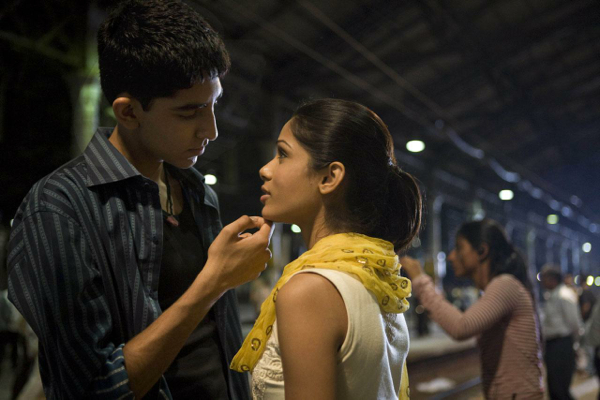Movie review by Greg Carlson
From “The Village Voice” to “Variety,” reviews of Danny Boyle’s “Slumdog Millionaire” (co-directed with Loveleen Tandan) compare its inhabitants to the colorful street urchins and the cruel tormenters and exploiters of Charles Dickens. For anyone familiar with “Oliver Twist” or “David Copperfield,” the similarities are hard to ignore, and offer some idea of the film’s tone of triumph in the face of seemingly insurmountable odds. Simon Beaufoy’s screenplay, adapted from a novel by Vikas Swarup, channels Dickens in other ways as well, spinning coincidences so preposterous that one becomes nearly dizzy at the thought of how everything is sewn together. Boyle is certainly a talented filmmaker, and has been especially interesting because his body of work resists the kind of stylistic calling cards that define, and often confine, some of his peers.
Jamal (Dev Patel), a chai wallah from the slums of Mumbai, moves from one hot seat to another when he is suspected of cheating on his way to a fortune as a contestant on “Who Wants to Be a Millionaire?” Underdog stories can be catnip, especially in tough times, and many of us have imagined what it might be like to attain fabulous wealth for being able to answer seemingly trivial questions. Relying on the painful memories of his patchwork childhood to provide the information he needs, Jamal navigates his way through the game to the astonishment of its cocky host – played by Anil Kapoor, whose growled refrain of “Who wants to be a mill-a-NAIRE?” is one of the movie’s curious pleasures. As Jamal climbs from one question to another, Boyle transports the viewer back to a corresponding anecdote from the character’s past.
While many have sung the praises of the film’s construction, calling it anything from ingenious to a metaphoric “river of life,” it is instead a liability for many viewers who will find themselves torn between an interest in filling in the blanks of Jamal’s past and the momentum of the much shorter scenes that take place on the set of the game show. Boyle uses three actors of different ages for each member of the trio of principal characters, and of those nine performers, some command more attention than others – always a risk when using this technique. Patel is certainly charming, and Freida Pinto is lovely as Latika, the young woman Jamal loves – even though they do not share much screen time.
Boyle practically taunts his audience with the range of events he chooses to show on camera. The film bounds wildly from a triumphant positivism that explains why the movie is constantly pasted with the dreaded “feel good” tag to the ghastly sight of a few nearly unspeakable horrors visited upon vulnerable orphans. Boyle does not flinch when staging scenes like an odious dunking in an excrement-filled latrine, which is played mostly for slapstick comedy, but some of the darker material will disturb sensitive viewers.
More stomach-churning is the depiction of a child being maimed, and it is certainly open to debate whether Boyle pushes too far to make his point. Perhaps the director would argue that the poverty of Mumbai demands a shockingly graphic treatment of the lives of its most destitute children, but so much of the film is calculating and manipulative in the direction of fantasy-come-true that the juxtaposition of the sweet and the heinous threatens to unravel the whole movie.
